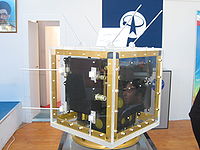
Photo from wikipedia
OBJECTIVE The goal of this study was to analyze the visibility of women within organized neurosurgery, including leadership positions, lectureships, and honored guest/award recipients at neurosurgical conferences. METHODS A cross-sectional… Click to show full abstract
OBJECTIVE The goal of this study was to analyze the visibility of women within organized neurosurgery, including leadership positions, lectureships, and honored guest/award recipients at neurosurgical conferences. METHODS A cross-sectional study was used to analyze the gender demographics within the five major national neurosurgical societies (Congress of Neurological Surgeons [CNS], American Association of Neurological Surgeons [AANS], Society of Neurological Surgeons [SNS], American Board of Neurological Surgery [ABNS], and Council of State Neurosurgical Societies [CSNS]) from 2000 to 2020. Data for top leadership positions, keynote speakers, honored guests, and invited lectureships at these neurosurgical societies were reviewed. Additionally, national neurosurgical residency match data from 2018 to 2020 were collected. For each aforementioned data point, gender was determined and confirmed via publicly available data. Data from the US News and World Report best hospitals publication for 2020 were applied for analyzing gender trends within neurosurgical residencies specifically. RESULTS In the past 2 decades (2000-2020), top leadership positions across the neurosurgical organizations were held by 45 individuals, of whom 5 (11.1%) were women. Spanning from 2000 to 2018, just 8.1% (50 of 618) of guests/honored speakers on the national neurosurgical stage of the CNS, AANS, SNS, and CSNS meetings have been female. Excluding the Louise Eisenhardt Lecture (honoring women), the percentage of female guests/honored speakers at the AANS meeting was just 5% (17 of 367). For the CNS annual meetings, 13.4% (20 of 149) of the speakers were women from 2000 to 2018, whereas the CSNS annual meeting data from 2001 to 2018 found that 11.9% (7 of 59) of speakers were women. From 1952 to the present, there have been no female honored guests at the CNS annual meeting. Across the residency match cycles from 2018 to 2020, the percentages of matched applicants identifying as female have been 22.7%, 28.1%, and, most recently, 25.3%. The percentage of female residents is 28.5% (top 20 program) versus 24.3% (non-top 20 program) (p = 0.267). CONCLUSIONS This study found that for all the data points surveyed, including leadership positions, invited lectureships at national neurosurgical meetings, and successful neurosurgical residency applicants, disproportionate female underrepresentation was evident. Consistent lack of visibility leads to a negative impact on progress in the recruitment and retention of women in neurosurgery. Visibility, mentorship, role models, and sponsorship are highly interrelated processes and are essential for meaningful progress.
Journal Title: Neurosurgical focus
Year Published: 2021
Link to full text (if available)
Share on Social Media: Sign Up to like & get
recommendations!